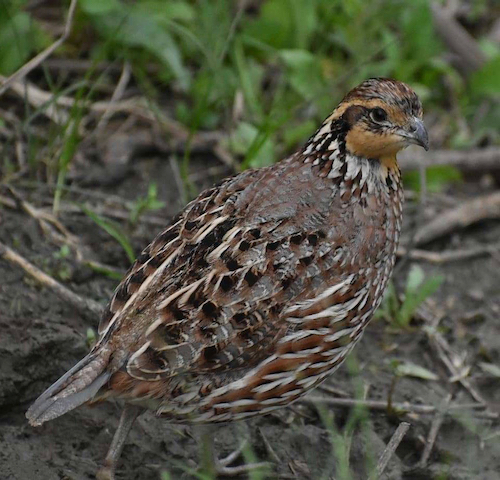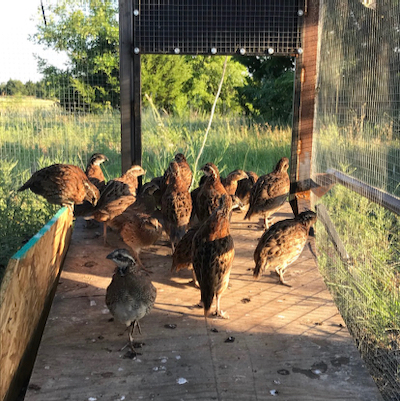Several years ago, the Lewisville Lake Environmental Learning Area (LLELA), under the direction of Dr. Ken Steigman, began releasing Northern Bobwhite quail in order to restore them to the LLELA nature area. About the same time, the Connemara Conservancy Meadow Nature Preserve began to do the same thing, as Bobwhites had last been seen in the Meadow in 1999.
 During the Summer of 2019, two pair of the released Bobwhites in the Meadow successfully hatched and raised chicks. This was a major milestone accomplishment and led to a meeting between LLELA and Connemara last December to discuss various techniques, lessons learned and plans for the future.
During the Summer of 2019, two pair of the released Bobwhites in the Meadow successfully hatched and raised chicks. This was a major milestone accomplishment and led to a meeting between LLELA and Connemara last December to discuss various techniques, lessons learned and plans for the future.
One of the action items agreed to at the meeting was to jointly sponsor a Bobwhite restoration workshop as soon as possible in 2020 in order to interest other nature areas and localities in the possibility of restoring Bobwhites at their locations.
The Heard Museum and Nature Center agreed to host the workshop with attendees from the cities of Frisco, Plano, McKinney, Allen, the Ft. Worth Nature Center, the Blackland Prairie Raptor Center, various representatives from local Audubon chapters and the president of the East Texas Bobwhite Restoration chapter among other interested individuals attending the event on Jan 24, 2020. Various presentations were made throughout the workshop with the idea of encouraging other organizations and individuals to get on the Bobwhite restoration bandwagon.
In early Spring of 2020, the City of Plano and the Blackland Prairie Raptor Center opted in for Bobwhite restoration and began close cooperation with Connemara. In April, 2020, Kristen and Mark Payne, long-time supporters of the Bobwhite restoration efforts at the Meadow, delivered 215 four-week old chicks to the Meadow.
These chicks were fed a diet that included medication to take care of internal parasites and other diseases. Of the 215 delivered, 205 survived thanks to the constant care provided by Steve Thier, a volunteer at the Meadow.
An agreement was reached with LLELA, the City of Plano, and the Raptor Center that each organization would take about 1/4 of the Bobwhites to be released at their locations. Prior to the release, volunteers at LLELA were able to take photos of two broods of chicks from Bobwhites released in 2019 at the LLELA Nature area providing proof that the release effort at LLELA was working.
The 2020 release process began with the City of Plano in early June, then with LLELA, and finished with the Raptor Center on June 27. In each case, Bobwhites were taken from the Meadow, placed in "holding pens" for a few days in order for them to get used to their new surroundings, and then released. Connemara released their Bobwhites on June 29.
A long-term goal of the restoration effort is for the Bobwhite populations at each location to begin reproducing on their own. Another goal is to interest other cities, nature areas and private landowners in Bobwhite restoration so that this iconic ground nesting bird of Texas can return to its Blackland Prairie roots.
 "Each of the organizations involved in the Bobwhite restoration effort recognizes that this is a long-term effort, stretching over five years or more,” said Connemara Board President and Meadow Manager Bob Mione. “We hope that by working together and sharing information/techniques that our success rate of the released Bobwhites producing and successfully raising new chicks will continue to increase.”
"Each of the organizations involved in the Bobwhite restoration effort recognizes that this is a long-term effort, stretching over five years or more,” said Connemara Board President and Meadow Manager Bob Mione. “We hope that by working together and sharing information/techniques that our success rate of the released Bobwhites producing and successfully raising new chicks will continue to increase.”
As Ken Steigman told the members of our Bobwhite restoration workshop, "prior year's releases have revealed that these birds disperse much farther than many people realize. In addition to sharing ideas and birds, another reason we are working together is an attempt to create a metapopulation of bobwhites in adjacent cities and towns. There are many natural corridors that currently exist in this region, and more that can be created by habitat restoration.”
Bobwhites are short-lived birds. When bad years occur due to drought or extreme winters, some local populations may be diminished below the minimum covey density for survival. It is hoped that through the efforts of these many participating organizations that when this happens, surviving birds from adjacent populations will repopulate habitats during the next breeding season utilizing these corridors.
For more information or to volunteer to join Connemara’s Bobwhite restoration efforts, contact Connemara Board President and Meadow Manager Bob Mione at meadowmanager@connemaraconservancy.org or (214) 534-1900.